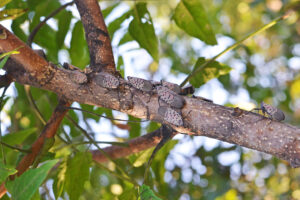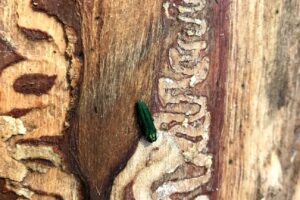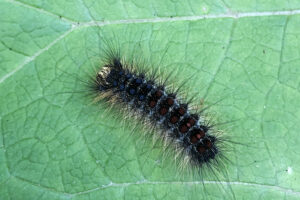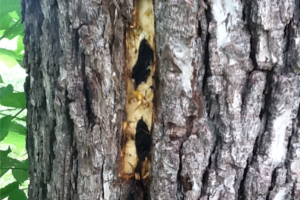Role in Forest Health
One aspect of forest health is the reduction of losses due to pest organisms, primarily insects and diseases. Many native and non-native insects and diseases can affect the native tree species in Virginia forests. Native insects and diseases can be an important part of the ecosystem, helping with nutrient recycling, acting as a food to source to other animals, and contributing to biodiversity. However, when these native pests reach high populations and outbreaks start, or when non-native pests enter our native ecosystems, trees can be negatively impacted.
Insects can be classified by how they damage the trees: wood borers bore into trees, defoliators eat leaves, and sapsuckers feed on the sap of trees. Diseases are also classified by parts of the tree they impact: root issues, foliage disorders, and wilts (which block the tissue that moves water and nutrients).
While many resources exist for identification and management descriptions, here are some resources the DOF Forest Health Program recommends.
To learn more about common insects, diseases, and abiotic disturbances in your trees, visit the Tree and Forest Health Guide!
| Image | Title | Description | View |
|---|---|---|---|
| Tree and Forest Health Guide: A handbook for the diagnosis of urban and rural forest disturbances | Book provides guidance about tree and forest health; conditions that are common or important enough in Virginia to gain frequent attention are covered. General guidelines are given for the diagnosis and treatment of biotic (living) and abiotic (non-living) disturbances of forests and individual trees. Guide should not be used as a final reference, but rather a quick field guide and training tool. | View | |
| Tree and Forest Health Guide: A handbook for the diagnosis of urban and rural forest disturbances (2-page spread) | Book provides guidance about tree and forest health; conditions that are common or important enough in Virginia to gain frequent attention are covered. General guidelines are given for the diagnosis and treatment of biotic (living) and abiotic (non-living) disturbances of forests and individual trees. Guide should not be used as a final reference, but rather a quick field guide and training tool. | View |
Common Insects in Virginia
Common Diseases in Virginia
Additional Resources
- Learn more about many forest health disturbances in the Southeastern U. S. at the Southern Research Extension Forestry Forest Health Website.
- Virginia Cooperative Extension offers great factsheets on numerous forestry issues.
- Get help with sick trees
| Image | Title | ID | Description | Date | Content Type | View | hf:tax:document-category | hf:tax:Media |
|---|---|---|---|---|---|---|---|---|
 | Forest Health Review 2024-12 | P00219 | Report provides an update on current forest health issues, such as invasive species, wavyleaf grass, pine bark beetles, spongy moth, emerald ash borer, hemlock woolly adelgid, vascular streak dieback, heterobasidium, beech leaf disease and more. | 12/31/2024 | Publication | View | forest-health | publication |
 | Don’t Move Firewood Flyer – Spanish – No Mueva La Lena | PST007 | Flyer advises citizens not to move firewood and prevent spreading tree-destroying insects and diseases. Printed copies available. | 05/01/2024 | Publication | View | forest-health | publication |
 | Don’t Move Firewood Flyer | PST007 | Flyer advises citizens not to move firewood and prevent spreading tree-destroying insects and diseases. Printed copies available. | 05/01/2024 | Publication | View | forest-health | publication |
 | Spongy Moth Control Methods – A Guide for Homeowners | FT0068 | Forestry topic information sheet describes spongy moth, the damage it causes, and how you can protect your trees using chemical and natural control methods. | 04/22/2024 | Publication | View | forest-health | publication |
 | Forest Health Review 2023-12 | P00219 | Report provides an update on current forest health issues, such as invasive species, wavyleaf grass, pine bark beetles, spongy moth, emerald ash borer, hemlock woolly adelgid, vascular streak dieback, heterobasidium, beech leaf disease and more. | 12/31/2023 | Publication | View | forest-health | publication |
 | Hemlock Woolly Adelgid Soil Drench Treatment | Video on how to treat hemlock trees using the soil drench method. | 07/18/2023 | Video | View | financial-assistance-forest-health urb forest-health urban-and-community-forestry | video | |
 | Hemlock Tree Management – Protection from the Hemlock Woolly Adelgid | FT0063 | Forestry topic information sheet discusses treatment options to protect hemlock trees from the damaging hemlock woolly adelgid. | 03/01/2023 | Publication | View | financial-assistance-forest-health urb forest-health urban-and-community-forestry | publication |
 | Forest Health Review 2022-12 | P00219 | Report provides an update on current forest health issues, such as weather impact, pine bark beetles, spongy moth, emerald ash borer, hemlock woolly adelgid, brown periodical cicadas, spotted lanternfly, Asian longhorned beetle, fall cankerworm, red imported fire ant, laurel wilt disease, oak decline, and more. | 12/31/2022 | Publication | View | forest-health | publication |
 | A Year in Forest Health – Calendar | One-page calendar identifies what forest health issues or occurrences are happening each month throughout the year. Learn what to look for each month. | 12/31/2022 | Document | View | education forest-health public-information | document | |
 | Common Pests of Oaks in Virginia – Common Pests and Diseases of Oak Trees | FT0059 | Forestry topic information sheet discusses the most common pests and diseases affecting oak trees in Virginia. | 04/25/2022 | Publication | View | forest-health | publication |
 | Forest Health Review 2021-12 | No # | Report provides an update on current forest health issues, such as weather impact, pine bark beetles, gypsy moth, emerald ash borer, hemlock woolly adelgid, brown periodical cicadas, spotted lanternfly, Asian longhorned beetle, fall cankerworm, and more. | 12/31/2021 | Publication | View | forest-health | publication |
 | Laurel Wilt Disease – A Threat to All Species in the Laurel Family | FT0056 | Forestry topic information sheet provides information about laurel wilt disease – a threat to all species in the Laurel family. Information includes the hosts, signs and symptoms, and how to manage the disease. | 09/13/2021 | Publication | View | forest-health | publication |
 | Forest Health Review 2021-01 | No # | Report provides an update on current forest health issues, such as weather impact, pine bark beetles, gypsy moth, emerald ash borer, hemlock woolly adelgid, brown periodical cicadas, spotted lanternfly, Asian longhorned beetle, fall cankerworm, and more. | 01/01/2021 | Publication | View | forest-health | publication |
| Beech Leaf Disease | R9–PR–001–21 | USDA Forest Service Pest Alert publication about beech leaf disease discusses identification and description, range, and management. | 01/01/2021 | Publication | View | forest-health | publication | |
| Tree and Forest Health Guide: A handbook for the diagnosis of urban and rural forest disturbances | P00217 | Book provides guidance about tree and forest health; conditions that are common or important enough in Virginia to gain frequent attention are covered. General guidelines are given for the diagnosis and treatment of biotic (living) and abiotic (non-living) disturbances of forests and individual trees. Guide should not be used as a final reference, but rather a quick field guide and training tool. | 09/01/2020 | Publication | View | forest-health | publication | |
| Tree and Forest Health Guide: A handbook for the diagnosis of urban and rural forest disturbances (2-page spread) | P00217 | Book provides guidance about tree and forest health; conditions that are common or important enough in Virginia to gain frequent attention are covered. General guidelines are given for the diagnosis and treatment of biotic (living) and abiotic (non-living) disturbances of forests and individual trees. Guide should not be used as a final reference, but rather a quick field guide and training tool. | 09/01/2020 | Publication | View | forest-health | publication | |
| Virginia Cooperative Spongy Moth Suppression Program | Publication provides information on the Spongy Moth Slow the Spread Program. | 09/01/2020 | Publication | View | forest-health | publication | ||
| Optimized Insecticide Dosage for Hemlock Woolly Adelgid Control in Hemlock Trees | Hemlock woolly adelgid (HWA) (Adelges tsugae) is killing hemlock trees in the eastern U.S. This invasive insect is native to Japan and has been in the eastern U.S. since the 1950’s. HWA feed by sucking fluids from hemlock twigs just at the base of the needles, depleting the tree of needed energy reserves. Large swaths of hemlock forests have been decimated by HWA, and millions of hemlocks have died. This publication provides information about optimized dosage for HWA control in hemlock trees | 02/01/2020 | Publication | View | forest-health | publication | ||
 | Forest Health Review 2020-01 | No # | Report provides an update on current forest health issues, such as weather impact, pine bark beetles, gypsy moth, emerald ash borer, hemlock woolly adelgid, brown marmorated stink bug, spotted lanternfly, and more. | 01/01/2020 | Publication | View | forest-health | publication |
| Integrating Chemical and Biological Control of the Hemlock Woolly Adelgid: a Resource Manager’s Guide | FHAAST-2018-04 | A non-native invasive insect, the hemlock woolly adelgid (HWA), threatens the ability of natural resource managers to maintain eastern and Carolina hemlocks as critical components of unique forest ecosystems in eastern North America. Although substantial progress has been made in both chemical and biological control of HWA, neither of these tactics applied alone are expected to provide adequate control of HWA throughout its introduced range. This guide presents a methodological strategy for integrating biological and chemical control together in the same forest stands. | 01/01/2020 | Publication | View | forest-health | publication | |
| Biology and Management of the Hemlock Woolly Adelgid in the Eastern U.S. | SREF-FH-012 | Hemlock wooly adelgid (HWA) is a small insect that causes huge problems. Learn more about this insect in this publication including information on how to identify it, its lifecycle, and distribution as well as the damage it causes and tactics for managing it. This Southern Region Extension Forestry publication provides additional information about the biology and management of HWA. | 05/01/2019 | Publication | View | forest-health | publication | |
 | Forest Health Review 2019-01 | No # | Report provides an update on current forest health issues, such as weather impact, pine bark beetles, gypsy moth, emerald ash borer, hemlock woolly adelgid, brown marmorated stink bug, spotted lanternfly, and more. | 01/01/2019 | Publication | View | forest-health | publication |
 | Forest Health Review 2018-01 | No # | Report provides an update on current forest health issues, such as weather impact, pine bark beetles, gypsy moth, emerald ash borer, hemlock woolly adelgid, brown marmorated stink bug, spotted lanternfly, and more. | 01/01/2018 | Publication | View | forest-health | publication |
| Hemlock Woolly Adelgid Biology and Management in the Southeastern U.S. | Webinar about HWA biology and management in the Southeastern U.S. | 03/29/2017 | Resource | View | forest-health | resource | ||
 | Forest Health Review 2017-01 | No # | Report provides an update on current forest health issues, such as weather impact, pine bark beetles, gypsy moth, emerald ash borer, hemlock woolly adelgid, brown marmorated stink bug, spotted lanternfly, and more. | 01/01/2017 | Publication | View | forest-health | publication |
 | Forest Health Review 2016-02 | No # | Report provides an update on current forest health issues, such as weather impact, pine bark beetles, gypsy moth, emerald ash borer, hemlock woolly adelgid, brown marmorated stink bug, spotted lanternfly, and more. | 02/01/2016 | Publication | View | forest-health | publication |
 | Don’t Move Firewood | P00135 | Brochure advises citizens to leave their firewood at home, explaining the danger of spreading tree-destroying insects and diseases. Printed copies available. | 09/01/2015 | Publication | View | forest-health | publication |
 | Forest Health Review 2014-12 | No # | Report provides an update on current forest health issues, such as weather impact, pine bark beetles, gypsy moth, emerald ash borer, hemlock woolly adelgid, brown marmorated stink bug, spotted lanternfly, and more. | 12/01/2014 | Publication | View | forest-health | publication |
 | Forest Health Review 2014-02 | No # | Report provides an update on current forest health issues, such as weather impact, pine bark beetles, gypsy moth, emerald ash borer, hemlock woolly adelgid, brown marmorated stink bug, spotted lanternfly, and more. | 02/01/2014 | Publication | View | forest-health | publication |
 | Forest Health Review 2013-01 | No # | Report provides an update on current forest health issues, such as weather impact, pine bark beetles, gypsy moth, emerald ash borer, hemlock woolly adelgid, brown marmorated stink bug, spotted lanternfly, and more. | 01/01/2013 | Publication | View | forest-health | publication |
 | Forest Health Review 2012-07 | No # | Report provides an update on current forest health issues, such as weather impact, pine bark beetles, gypsy moth, emerald ash borer, hemlock woolly adelgid, brown marmorated stink bug, spotted lanternfly, and more. | 07/01/2012 | Publication | View | forest-health | publication |
 | Forest Health Review 2011-11 | No # | Report provides an update on current forest health issues, such as weather impact, pine bark beetles, gypsy moth, emerald ash borer, hemlock woolly adelgid, brown marmorated stink bug, spotted lanternfly, and more. | 11/01/2011 | Publication | View | forest-health | publication |
 | Forest Health Review 2011-05 | No # | Report provides an update on current forest health issues, such as weather impact, pine bark beetles, gypsy moth, emerald ash borer, hemlock woolly adelgid, brown marmorated stink bug, spotted lanternfly, and more. | 05/01/2011 | Publication | View | forest-health | publication |
 | Forest Health Review 2010-11 | No # | Report provides an update on current forest health issues, such as weather impact, pine bark beetles, gypsy moth, emerald ash borer, hemlock woolly adelgid, brown marmorated stink bug, spotted lanternfly, and more. | 11/01/2010 | Publication | View | forest-health | publication |
 | Forest Health Review 2010-05 | No # | Report provides an update on current forest health issues, such as weather impact, pine bark beetles, gypsy moth, emerald ash borer, hemlock woolly adelgid, brown marmorated stink bug, spotted lanternfly, and more. | 05/01/2010 | Publication | View | forest-health | publication |
 | Forest Research Review 2010-03 | Research reports and updates from ongoing DOF studies. In this issue: loblolly pine site index, stem sinuosity in loblolly pine, longleaf pine establishment methods, American chestnut, effects of competing hardwoods on loblolly pine, white pine competition control and storage time, tip moth control methods for loblolly pine, white oak crop tree release and fertilization. | 03/01/2010 | Publication | View | research-resource-information resource-information | publication | |
 | Forest Health Review 2009-11 | No # | Report provides an update on current forest health issues, such as weather impact, pine bark beetles, gypsy moth, emerald ash borer, hemlock woolly adelgid, brown marmorated stink bug, spotted lanternfly, and more. | 11/01/2009 | Publication | View | forest-health | publication |
 | Don’t Move Firewood Flyer | 426-106 | Flyer advises citizens to leave their firewood at home, explaining the danger of spreading tree-destroying insects and diseases. This is a previous version that is still available to use until supply is depleted. | 05/01/2009 | Publication | View | forest-health | publication |
 | Forest Health Review 2009-05 | No # | Report provides an update on current forest health issues, such as weather impact, pine bark beetles, gypsy moth, emerald ash borer, hemlock woolly adelgid, brown marmorated stink bug, spotted lanternfly, and more. | 05/01/2009 | Publication | View | forest-health | publication |
 | Forest Research Review 2009-04 | Research reports and updates from ongoing DOF studies. In this issue: potential for continued loblolly pine tree improvement, effects of thinning and fertilization in loblolly pine, American chestnut breeding program, longleaf pine provenance study, biosolids for fertilizing loblolly pine, interplanting loblolly pine, tip moth control methods for loblolly pine, and southern red oak crop tree release and fertilization. | 04/01/2009 | Publication | View | research-resource-information resource-information | publication | |
| Gypsy Moth (Spongy Moth) Management for Homeowners on Small Properties | This factsheet details the life cycle and biology of the spongy moth. | 01/01/2009 | Resource | View | forest-health | resource | ||
 | Forest Health Review 2008-11 | No # | Report provides an update on current forest health issues, such as weather impact, pine bark beetles, gypsy moth, emerald ash borer, hemlock woolly adelgid, brown marmorated stink bug, spotted lanternfly, and more. | 11/01/2008 | Publication | View | forest-health | publication |
 | Forest Research Review 2008-10 | Research reports and updates from ongoing DOF studies. In this issue: loblolly pine seed orchard management strategies, advances in pine plantation silviculture, longleaf pine grafting methods, competition control for shortleaf pine establishment, tip moth control methods for loblolly pine, tree-of-heaven control methods, and northern red oak planting. | 10/01/2008 | Publication | View | research-resource-information resource-information | publication | |
 | Forest Health Review 2008-05 | No # | Report provides an update on current forest health issues, such as weather impact, pine bark beetles, gypsy moth, emerald ash borer, hemlock woolly adelgid, brown marmorated stink bug, spotted lanternfly, and more. | 05/01/2008 | Publication | View | forest-health | publication |
 | Forest Health Review 2007-11 | No # | Report provides an update on current forest health issues, such as weather impact, pine bark beetles, gypsy moth, emerald ash borer, hemlock woolly adelgid, brown marmorated stink bug, spotted lanternfly, and more. | 11/01/2007 | Publication | View | forest-health | publication |
 | Don’t Move Firewood – Spanish – No Transport Lena | P00136 | Brochure advises citizens to leave their firewood at home, explaining the danger of spreading tree-destroying insects and diseases. | 08/01/2007 | Publication | View | forest-health | publication |
 | Forest Health Review 2007-05 | No # | Report provides an update on current forest health issues, such as weather impact, pine bark beetles, gypsy moth, emerald ash borer, hemlock woolly adelgid, brown marmorated stink bug, spotted lanternfly, and more. | 05/01/2007 | Publication | View | forest-health | publication |
 | Forest Health Review 2006-11 | No # | Report provides an update on current forest health issues, such as weather impact, pine bark beetles, gypsy moth, emerald ash borer, hemlock woolly adelgid, brown marmorated stink bug, spotted lanternfly, and more. | 11/01/2006 | Publication | View | forest-health | publication |
 | Forest Health Review 2006-04 | No # | Report provides an update on current forest health issues, such as weather impact, pine bark beetles, gypsy moth, emerald ash borer, hemlock woolly adelgid, brown marmorated stink bug, spotted lanternfly, and more. | 04/01/2006 | Publication | View | forest-health | publication |
 | Forest Health Review 2005-09 | No # | Report provides an update on current forest health issues, such as weather impact, pine bark beetles, gypsy moth, emerald ash borer, hemlock woolly adelgid, brown marmorated stink bug, spotted lanternfly, and more. | 09/01/2005 | Publication | View | forest-health | publication |
 | No. 113 Controlling Herbaceous Competition and Tip Moth – Effects After 16 Years; by T. A. Dierauf and J. A. Scrivani | OR-113 | Report describes the effects of four treatments – herbaceous vegetation control, tip moth control, herbaceous vegetation and tip moth control combined, and no treatment – on loblolly pine growth through age 16. Herbaceous control increased height by 2 feet, diameter by 0.5 inches, and basal area by 25 square feet. Tip moth control had only slight effects on those attributes. | 03/01/1994 | Publication | View | research-resource-information resource-information | publication |
| Spotted Lanternfly in Virginia | Information on how to identify the spotted lanternfly or find additional resources are available on this Virginia Cooperative Extension website. | Resource | View | forest-health | resource | |||
 | Emerald Ash Borer in Virginia | Information about emerald ash borer in Virginia. | StoryMap | View | forest-health | storymap | ||
 | Emerald Ash Borer Program | Learn more about the ash treatment financial assistance program and to see the work that has been done so far. | StoryMap | View | urb financial-assistance-forest-health forest-health urban-and-community-forestry | storymap | ||
| Insecticide Options for Protecting Ash Trees from Emerald Ash Borer | Learn more about all treatment options available for ash trees with this multi-state emerald ash borer insecticide fact sheet. | Publication | View | forest-health | publication | |||
 | Southern Pine Beetle | Information about the southern pine beetle and the problems it can cause. | StoryMap | View | forest-health | storymap | ||
| Oak Decline in Virginia | This report provides an overview of oak decline and the factors that cause it. | Publication | View | forest-health | publication | |||
| Walnut Thousand Cankers Disease Alert | This Virginia Cooperative Extension factsheet will help detail thousand cankers disease {TCD} and what symptoms to be on the lookout for. | Publication | View | forest-health | publication | |||
| Red Imported Fire Ant | Information about the red imported fire ant (RIFA). | Publication | View | forest-health | publication |
Contact Us
For more information or questions, e-mail us or use our contact form.




